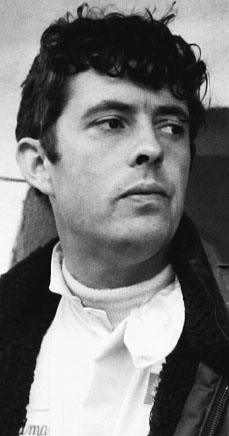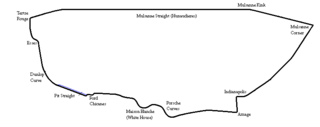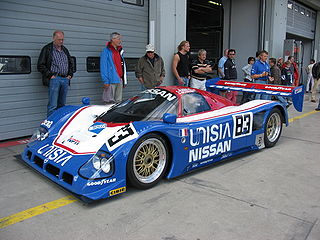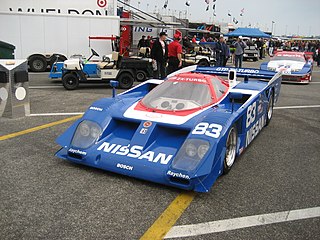
The Porsche 935 is a race car that was developed and manufactured by German automaker Porsche. Introduced in 1976 as the factory racing version of the 911 (930) Turbo and prepared for FIA-Group 5 rules, it was an evolution of the Carrera RSR 2.1 turbo prototype, the second place overall finisher in the 1974 24 Hours of Le Mans.

Brian Herman Thomas Redman, is a retired British racing driver.

The Porsche 962 is a sports prototype racing car designed and built by Porsche. Created to replace the Porsche 956, 962 was introduced at the end of 1984 and replaced the 956 in the IMSA's GTP class in 1985 due to regulation changes obsoleting the 956. It was also introduced in the World Sportscar Championship's Group C category in 1984. Over its decade-long career, the car in its Group C form won the 24 Hours of Le Mans twice, with a derivative of the car, the Dauer 962 Le Mans, winning a further title in 1994. In total, the 962 scored nineteen total constructor's championships across various series. The 962's successor was the Porsche WSC-95, introduced for the 1996 24 Hours of Le Mans, but did not receive factory backing or support.

A Daytona Prototype was a type of sports prototype racing car developed specifically for the Grand American Road Racing Association's Rolex Sports Car Series as their top class of car, which replaced their main prototype racing class, specifically Le Mans Prototypes (LMPs). The cars later competed in the merged series of the IMSA SportsCar Championship, from 2014 to 2016, before being phased out and replaced by the Daytona Prototype International class in 2017. They are named after the main series event, the Rolex 24 at Daytona.

The 1982 24 Hours of Le Mans was the 50th Grand Prix of Endurance, which took place on 19 and 20 June 1982. It was also the fourth round of the 1982 World Endurance Championship. As well as a significant anniversary, this was a watershed year for Le Mans, with the highly anticipated advent of the FIA's Group C regulations, the essence of which was to allow an open engine formula but a minimum weight for safety and a proscribed fuel allocation.

The 1981 24 Hours of Le Mans was the 49th Grand Prix of Endurance, and took place on 13 and 14 June 1981. It was also the eighth round of the World Endurance Championship of Drivers, and the fifth round of the World Championship for Makes.

The 1980 24 Hours of Le Mans was the 48th Grand Prix of Endurance, and took place on 14 and 15 June 1980. It was the seventh round of both the World Championship for Makes and World Challenge for Endurance Drivers. With neither the Porsche nor Renault works teams contesting the big Group 6 sports-cars for outright victory, it left the prospects open for a privateer victory from Joest, Rondeau or De Cadenet, or from Group 5 again, if they were to fail. The wet weather throughout the race further added to the uncertainty, reducing the advantage of the more powerful cars.

The 1979 24 Hours of Le Mans was the 47th Grand Prix of Endurance, and took place on 9 and 10 June 1979. With no other major works cars this year, the Porsche team were the strong favourites to win. Their competition would be from Cosworth-powered Mirages and Rondeaus and a swarm of Group 5 and IMSA-class Porsche 935s. The other big talking point was the presence of Hollywood actor Paul Newman, driving for Dick Barbour Racing.

The 1978 24 Hours of Le Mans was the 46th Grand Prix of Endurance, and took place on 10 and 11 June 1978. In many ways it was a continuation of the race from the year before – the two main protagonists would be the very evenly-matched works teams of Alpine-Renault and Porsche, with four cars each. The race was not valid for any championship.

The 1976 24 Hours of Le Mans was the 44th Grand Prix of Endurance, and took place on 12 and 13 June 1976. This year the FIA introduced its new Group 5 and Group 6 regulations and the race was now open to nine distinct classes, although it was still not part of the World Championship seasons. Porsche introduced its new models, the 936 in Group 6, the 935 in Group 5 and the 934 in Group 4. In response, BMW had its modified 3.0 CSL in Group 5. It was the year that turbos arrived in considerable numbers, with over a dozen turbocharged entries, led by the Renault Alpine A442. It saw the arrival of French prototype manufacturers Jean Rondeau and Gérard Welter in a new GTP class and a first-time invitation to American IMSA and NASCAR entries.
Group 5 was an FIA motor racing classification which was applied to four distinct categories during the years 1966 to 1982. Initially Group 5 regulations defined a Special Touring Car category and from 1970 to 1971 the classification was applied to limited production Sports Cars restricted to 5 litre engine capacity. The Group 5 Sports Car category was redefined in 1972 to exclude the minimum production requirement and limit engine capacity to 3 litres. From 1976 to 1982 Group 5 was for Special Production Cars, a liberal silhouette formula based on homologated production vehicles.

IMSA GT was a sports car racing series organized by International Motor Sports Association. Races took place primarily in the United States and occasionally in Canada.

Grand Touring Prototype (GTP) is the name of a former classification designated to sports prototypes in sports car racing competing in the IMSA GT Championship, maintained by IMSA between 1981 and 1993. The early cars were based on the almost same identical ruleset as the FIA's Group C category, but eventually evolved into a separate category. It was the successor to the Grand Touring Experimental (GTX) class, which were based on FIA Group 5 and Group 6 cars.

The Chevrolet Corvette GTP was an American Grand Touring Prototype-class sports prototype racing car which successfully participated in the IMSA Camel GT from 1984 until 1989. The car was professionally fielded in competition as General Motors' Chevrolet Corvette C4 official factory team effort in the IMSA GTP class.

The Nissan R90C was a platform used for Group C racing cars built in 1990 by Nissan Motors for competition in World Sportscar Championship (WSC) based in Europe and the All Japan Sports Prototype Championship (JSPC). The cars based on the basic R90C platform would compete until 1993 before Nissan chose to withdraw from sports car racing, not returning until 1997. It won three JSPC championships and several significant endurance races during its career.

The Nissan GTP ZX-Turbo was a series of racing cars developed for Nissan Motors by Electramotive Engineering to compete in the IMSA GT Championship. Running from 1985 to 1990, they were known for being the first car to defeat the Porsche 962 which had dominated IMSA's premiere GTP category. This led to Nissan winning the constructor's championship and 12 Hours of Sebring in 1989 and 1990. During 1990, the GTP ZX-Turbo was replaced by the newer NPT-90.
The Lola T616 is a sports prototype built by Lola Cars to the Group C2 and IMSA GTP regulations. It was built with the intention to compete in the IMSA GT Championship and the World Sportscar Championship, and became the second Mazda-powered prototype to score a class win at the 24 Hours of Le Mans after the 717C triumphed in the same C2 class at the 1983 24 Hours of Le Mans.
Andrew Thorby is a British racecar designer. Thorby designed many formula racing and Le Mans Prototype cars.

The March 85G was a mid-engined IMSA racing sports prototype, designed and developed by March Engineering in 1984 and used in sports car racing until 1988.

Grand Touring Experimental (GTX) is a former classification and set of regulations designated to grand touring cars and sports prototypes in sports car racing competing in the IMSA GT Championship, maintained by IMSA between 1977 and 1982. Some cars were based on FIA Group 5 rules; such as the Porsche 935, and some cars were based on FIA Group 6 regulations, such as the Lola T600. Like the original GTO class, the class rules specified turbocharging and supercharging was allowed on engines up to a size of 6.0 L (370 cu in); with engine design and number of cylinders being free and unrestricted. Engines over 6.0 L (370 cu in) were required to be naturally-aspirated.


















